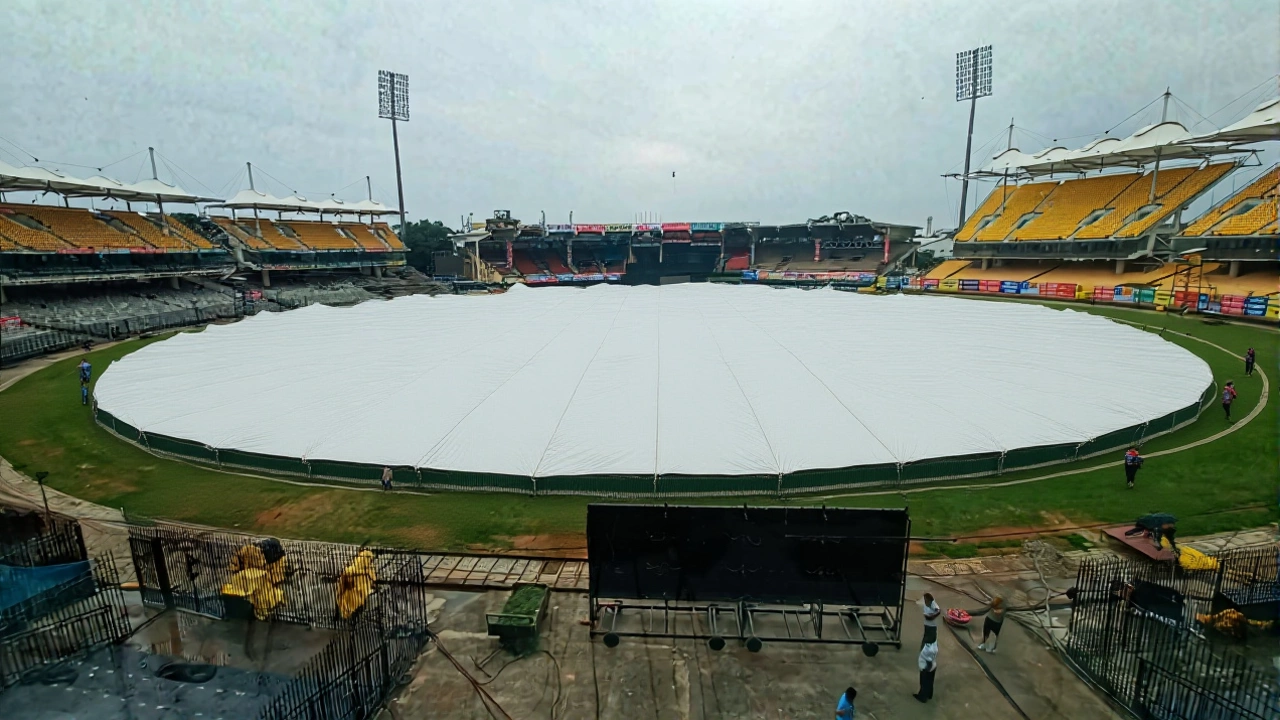When Suryakumar Yadav, captain of India National Cricket Team steps onto the field at MA Chidambaram Stadium in Chennai, the stage is set for the second India vs England T20IChennai on Saturday evening. The first match, a seven‑wicket win at Eden Gardens, gave India a 1‑0 lead in a five‑game series. The big question now: will the weather stay friendly and will spin bowlers again turn the tide?
Weather Forecast and Its Impact
All the major weather services – InsideSport.in, CricketAddictor.com, Financial Express, Business Standard, Moneycontrol.com, Firstpost.com, LatestLY.com and NewsBytesApp.com – are singing from the same hymn sheet: no rain. Temperatures will hover between 20 °C and 29 °C, humidity will sit in the high 60s to low 80s, and wind will drift at 13‑17 km/h. In plain English, the sky will be clear enough for a full‑length spectacle, and the slightly cooler night should ease the usual Chennai heat that can sap a bowler’s stamina.
- High: 29 °C (Financial Express, Business Standard)
- Low: 21 °C (InsideSport.in)
- Rain chance: 1 % (Firstpost.com)
- Humidity: 65‑83 % (various sources)
- Wind: 13‑17 km/h (InsideSport.in)
Why does this matter? A dry pitch combined with moderate humidity often yields a bit of bounce, which can help both fast bowlers and spinners. The lack of rain means the ground crews won’t have to roll a fresh surface, so the track’s natural character – traditionally slow and spin‑friendly – will stay intact.
Venue History and Pitch Conditions
The MA Chidambaram Stadium has witnessed nine T20I fixtures. Six of those have been won by teams batting first, while two victories came from sides chasing. The average first‑innings total sits around 150‑174 runs, depending on the data set, which suggests a modest scoring environment.
Notable records: the highest total, 189/4, came when South Africa chased down a target against India; the lowest, 80 all out, was Pakistan’s collapse against England. The biggest chase, 182/4, was pulled off by India against the West Indies, and the lowest defended score was 103/8 by West Indies against Pakistan. These numbers reinforce the notion that a decent start is crucial – a sub‑150 score can be deadly, but a 170‑plus total often puts the pressure back on the opposition.
Spin has historically been the hero here. The ground’s slow‑turning nature rewards accurate, flighted deliveries. Think of Varun Chakravarthy’s three‑wicket haul (23 runs) in the first game – a surprise spinner who capitalised on the surface’s grip. However, early IPL matches this year have shown a slightly more batting‑friendly bounce on fresh wickets, meaning teams might see a hybrid scenario: helpful spin but also the chance for big hitters to clear the in‑field.
Team Form and Key Players to Watch
India arrived in Chennai riding the confidence of a dominant win. Captain Suryakumar Yadav has managed just two fifties in his last 11 innings, and a three‑ball duck in Kolkata raised eyebrows. Still, his aggressive intent could be the spark England needs to chase down a lofty total.
For England, the core trio of Jos Buttler, Liam Livingstone and Ben Duckett will need to rediscover their rhythm after a middle‑order collapse. Buttler’s finishing flair could prove decisive, while Livingstone’s power-hitting offers a counter‑balance.
Bowling-wise, the spotlight is on Varun Chakravarthy. After an economy‑saving spell at Eden Gardens, he could become the match‑winner if he extracts turn on a drying surface. On the pace front, the fitness of Mohammed Shami remains a talking point. He missed the first game, but reports suggest he’s back in the nets and could replace Nitish Kumar Reddy if the management feels a fresh pair of hands are needed.

Tactical Battle & Predictions
The toss is set for 6:30 PM IST. Winning the toss and electing to bat could be a smart move; historically, batting first has yielded six wins at this venue. A solid opening partnership aiming for 80‑90 runs would set a platform for a 150‑plus total, curling the pressure onto England’s chase.
If England wins the toss, they might back the spin‑friendly surface and chase, banking on their middle order to handle the final overs. But remember, the highest successful chase at Chepauk is 182/4 – a target that requires a blend of measured accumulation and outright power.
My gut says India will bat first, post a 160‑165 total, and rely on Chakravarthy plus the revived Shami to tighten the leash. Expect a low‑scoring thriller – perhaps around 150 runs per side – with the match decided in the last two overs.
What’s Next for the Series?
Saturday’s game could put India up 2‑0, shifting the momentum dramatically. A 2‑0 lead in a five‑match series means England would have to win the next three straight – a daunting task, especially away from home. The third match is slated for Kolkata on Jan 28, where the conditions will swing drastically, giving England a glimmer of hope.
Regardless of the outcome, the Chennai showdown will provide a clear indicator of how both squads handle pressure, spin on a classic Indian wicket, and the endurance needed for a long series in sub‑continental climates.

Key Facts
- Match: India vs England 2nd T20I
- Date & Time: 25 January 2025, 7:00 PM IST
- Venue: MA Chidambaram Stadium, Chennai
- Weather: No rain, 20‑29 °C, humidity 65‑83 %
- Key Players: Suryakumar Yadav (c), Varun Chakravarthy, Mohammed Shami, Jos Buttler, Liam Livingstone
- Series Score: India leads 1‑0
Frequently Asked Questions
How will the weather affect the pitch at Chepauk?
The forecast shows clear skies and a low chance of rain, meaning the surface will stay dry. A dry, slightly warm track usually slows down, giving spin bowlers like Varun Chakravarthy extra grip, while the modest temperature drop in the evening eases fatigue for fast bowlers.
What does a win in Chennai mean for India’s series chances?
A 2‑0 lead puts India in a commanding position. England would then need to win three straight matches, a tall order on foreign soil. The psychological edge of a clean sweep could also influence player confidence in the remaining games.
Is Mohammed Shami likely to play the second T20I?
Reports from Times Now News and Moneycontrol indicate Shami has been training in the nets and is recovering well. If the management feels a veteran pacer is needed, he could replace the debutant Nitish Kumar Reddy in the XI.
Which England batsmen have the best chance to turn the game around?
Jos Buttler’s finishing ability and Liam Livingstone’s power-hitting are England’s main weapons. If they can stitch together a partnership of 80‑90 runs, they’ll give England a realistic target even on a spin‑friendly wicket.
How does the average first‑innings score at Chepauk compare to other Indian venues?
At about 150‑174 runs, Chepauk’s average is slightly lower than venues like the Wankhede or Eden Gardens, where scores often breach 180. The lower average reflects the pitch’s slower nature, emphasizing the importance of building partnerships rather than blitzing the scoreboard.
